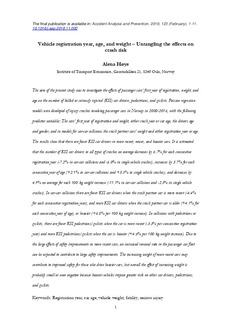| dc.description.abstract | The aim of the present study was to investigate the effects of passenger cars’ first year of registration, weight, and age on the number of killed or seriously injured (KSI) car drivers, pedestrians, and cyclists. Poisson regression models were developed of injury crashes involving passenger cars in Norway in 2000–2016, with the following predictor variables: The cars’ first year of registration and weight, either crash year or car age, the drivers age and gender, and in models for car-car collisions the crash partner cars’ weight and either registration year or age. The results show that there are fewer KSI car drivers in more recent, newer, and heavier cars. It is estimated that the number of KSI car drivers in all types of crashes on average decreases by 6.7% for each consecutive registration year (-7.2% in car-car collisions and -6.0% in single vehicle crashes), increases by 3.7% for each consecutive year of age (+2.1% in car-car collisions and +5.3% in single vehicle crashes), and decreases by 4.9% on average for each 100 kg weight increase (-11.1% in car-car collisions and -2.3% in single vehicle crashes). In car-car collisions there are fewer KSI car drivers when the crash partner car is more recent (-4.4% for each consecutive registration year), and more KSI car drivers when the crash partner car is older (+4.1% for each consecutive year of age), or heavier (+6.8% per 100 kg weight increase). In collisions with pedestrians or cyclists, there are fewer KSI pedestrians/cyclists when the car is more recent (-3.3% per consecutive registration year) and more KSI pedestrians/cyclists when the car is heavier (+4.6% per 100 kg weight increase). Due to the large effects of safety improvements in more recent cars, an increased renewal rate in the passenger car fleet can be expected to contribute to large safety improvements. The increasing weight of more recent cars may contribute to improved safety for those who drive heavier cars, but overall the effect of increasing weight is probably small or even negative because heavier vehicles impose greater risk on other car drivers, pedestrians, and cyclists. | nb_NO |

